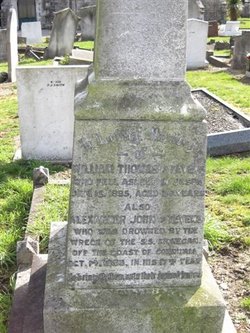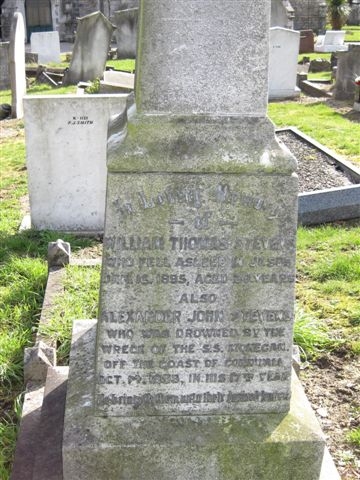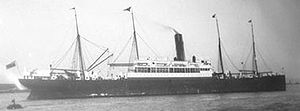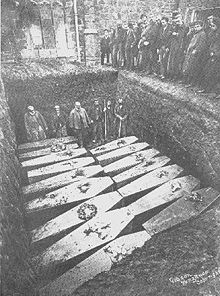The ship started life as the Cleopatra,launched April 1898. She was a mixed passenger liner and animal carrier. She was built alongside four others at Earle's Shipbuilding and Engine Company, Hull, for the Wilson & Furness-Leyland Line. She was rated A1 at Lloyd's of London. She was built for 'safety at sea' and was equipped with eight watertight bulkheads, failsafe lighting and pumping systems, eight lifeboats capable of carrying 59 passengers each and three compasses. She could carry 120 first class passengers, with stalls for 700 cattle.
She sailed on her maiden voyage from London to New York on 31 July 1898, arriving on 12 August 1898. A number of defects were quickly revealed, her water system feeding the boilers malfunctioned and there were a number of serious leaks. The blame was placed on a rushed construction, and the crew struggled to keep the ship operational. The passengers protested to the company about the poor condition of the ship, but also reported "the splendid conduct of the officers and crew." The Cleopatra returned to London,and limited to half-speed, the crossing took 21 days. Once she had docked an extensive programme of repairs was undertaken, which eventually lasted 41 days. She was then trialled, and inspected by the Board of Trade. She was pronounced fit to sail, and was renamed Mohegan in October 1898.Mohegan sailed from Tilbury Docks at 2:30pm on 13 October 1898, under the command of the 42 year old Captain Richard Griffith. She carried 57 passengers, 97 crew, seven cattlemen, and 1,286 tons of spirits, beer, and antimony. She arrived off Dover at 7:30 that evening, dropping her pilot. A report on the progress so far from the Assistant Engineer was probably landed at this time. A few minor leaks and electrical failures were reported but otherwise no major problems had been encountered.Mohegan then reached her maximum speed as she sailed down the English Channel bound for New York. She kept close to the coast as she passed Cornwall, but took the wrong bearing. This was noticed by some of the officers and crew. They had noticed that the Eddystone Lighthouse was too far away and the coast too close. She neared the entrance of Falmouth Harbour and turned towards the entrance of the Helford River and on down The Lizard coast without slowing from 13 knots. This was noticed by the Coverack coastguard, which attempted to signal to her with warning rockets. The Mohegan either was unaware or took no notice, and maintained her course. James Hill, coxwain of the Porthoustock lifeboat saw the ship, lights ablaze, heading at full speed towards the Manacle Rocks. With a cry of 'She's coming right in!' he called his crew.
Most of the recovered bodies of the drowned were buried in a mass gave in St Keverne churchyard, which was given a memorial stained glass window by the Atlantic Transport Line. Some bodies were sent to London for burial, whilst eight were shipped to New York on the Mohegan's sister ship Menominee. The Scottish poet William McGonagall immortalized the tragedy in his poem The Wreck of the Steamer "Mohegan". Most of the cargo was salvaged, though a diver lost his life in the process. The wreck gradually disintegrated in the following years. The third officer, William Logan Hindmarsh, age 30 is buried in the graveyeard in Coverack, with an inscription indicating that the boat company paid for his gravestone and interment.The ship rolled and sank 12 minutes after hitting the rocks, with the loss of 106 lives. Captain Griffith, Assistant Engineer William Kinley and all of the officers went down with the ship. Only her funnel and four masts remained above water. The Porthoustock lifeboat Charlotte was launched in 30 minutes and rescued most of the survivors from the wreck and the water; 44 persons were saved.
The ship started life as the Cleopatra,launched April 1898. She was a mixed passenger liner and animal carrier. She was built alongside four others at Earle's Shipbuilding and Engine Company, Hull, for the Wilson & Furness-Leyland Line. She was rated A1 at Lloyd's of London. She was built for 'safety at sea' and was equipped with eight watertight bulkheads, failsafe lighting and pumping systems, eight lifeboats capable of carrying 59 passengers each and three compasses. She could carry 120 first class passengers, with stalls for 700 cattle.
She sailed on her maiden voyage from London to New York on 31 July 1898, arriving on 12 August 1898. A number of defects were quickly revealed, her water system feeding the boilers malfunctioned and there were a number of serious leaks. The blame was placed on a rushed construction, and the crew struggled to keep the ship operational. The passengers protested to the company about the poor condition of the ship, but also reported "the splendid conduct of the officers and crew." The Cleopatra returned to London,and limited to half-speed, the crossing took 21 days. Once she had docked an extensive programme of repairs was undertaken, which eventually lasted 41 days. She was then trialled, and inspected by the Board of Trade. She was pronounced fit to sail, and was renamed Mohegan in October 1898.Mohegan sailed from Tilbury Docks at 2:30pm on 13 October 1898, under the command of the 42 year old Captain Richard Griffith. She carried 57 passengers, 97 crew, seven cattlemen, and 1,286 tons of spirits, beer, and antimony. She arrived off Dover at 7:30 that evening, dropping her pilot. A report on the progress so far from the Assistant Engineer was probably landed at this time. A few minor leaks and electrical failures were reported but otherwise no major problems had been encountered.Mohegan then reached her maximum speed as she sailed down the English Channel bound for New York. She kept close to the coast as she passed Cornwall, but took the wrong bearing. This was noticed by some of the officers and crew. They had noticed that the Eddystone Lighthouse was too far away and the coast too close. She neared the entrance of Falmouth Harbour and turned towards the entrance of the Helford River and on down The Lizard coast without slowing from 13 knots. This was noticed by the Coverack coastguard, which attempted to signal to her with warning rockets. The Mohegan either was unaware or took no notice, and maintained her course. James Hill, coxwain of the Porthoustock lifeboat saw the ship, lights ablaze, heading at full speed towards the Manacle Rocks. With a cry of 'She's coming right in!' he called his crew.
Most of the recovered bodies of the drowned were buried in a mass gave in St Keverne churchyard, which was given a memorial stained glass window by the Atlantic Transport Line. Some bodies were sent to London for burial, whilst eight were shipped to New York on the Mohegan's sister ship Menominee. The Scottish poet William McGonagall immortalized the tragedy in his poem The Wreck of the Steamer "Mohegan". Most of the cargo was salvaged, though a diver lost his life in the process. The wreck gradually disintegrated in the following years. The third officer, William Logan Hindmarsh, age 30 is buried in the graveyeard in Coverack, with an inscription indicating that the boat company paid for his gravestone and interment.The ship rolled and sank 12 minutes after hitting the rocks, with the loss of 106 lives. Captain Griffith, Assistant Engineer William Kinley and all of the officers went down with the ship. Only her funnel and four masts remained above water. The Porthoustock lifeboat Charlotte was launched in 30 minutes and rescued most of the survivors from the wreck and the water; 44 persons were saved.
Advertisement
Advertisement




